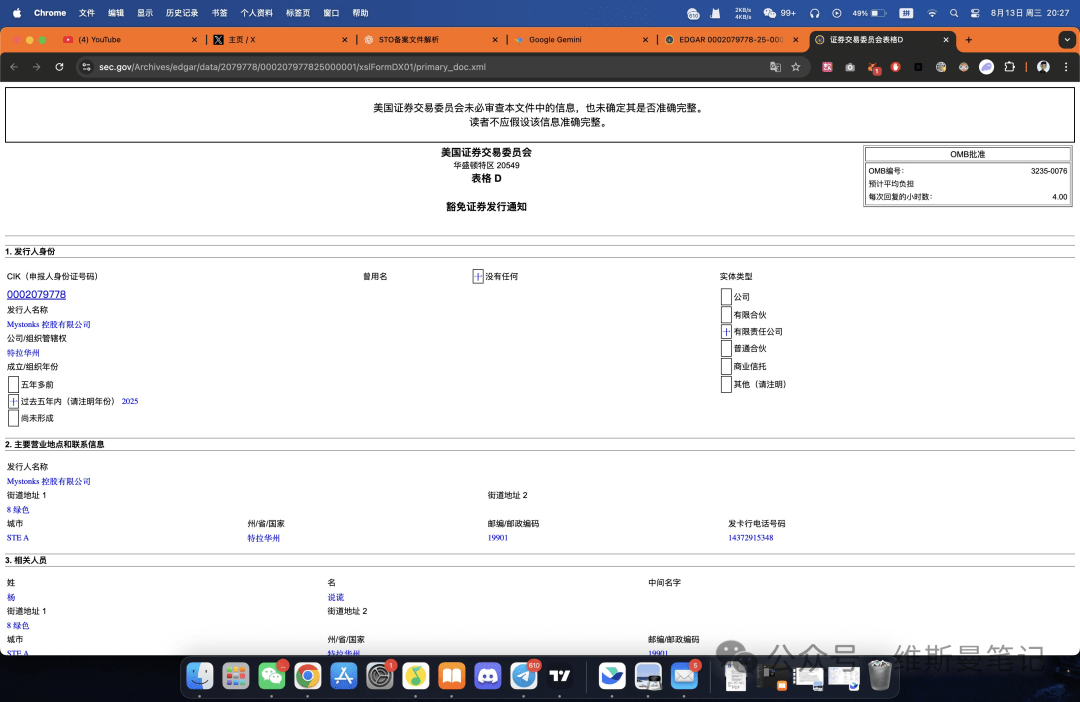Recently, a platform called Mystonks, which offers 'U.S. stocks on-chain,' sparked widespread controversy by freezing user funds. It is understood that the platform withheld a large amount of assets on the grounds of 'non-compliance with the source of user funds.'
From a financial compliance perspective, this handling method is highly unusual. A compliant financial institution, upon identifying suspicious funds, standard practice is to refuse acceptance and return the funds while submitting a report to the regulatory agency. The platform's direct 'withholding' of assets itself casts a huge question mark on its claimed 'compliance.'
The Mystonks platform has always promoted its possession of a U.S. MSB license and compliant issuance of STO as its core selling points. So, what is the truth behind these so-called 'compliance' qualifications? I conducted an investigation.
1. The Truth about 'Compliant STOs': Filing does not equal permission, private placement does not equal public offering.
During the investigation, I found that Mystonks' promotion is not entirely baseless. In the public database of the U.S. Securities and Exchange Commission (SEC), the filing information for Mystonks Holding LLC can indeed be found.
The core points of this document (Form D) are as follows:
● Filing type: Private placement exemption based on Regulation D 506(c) rules.
● Issuance target: Limited to 'accredited investors.'
● Issuance scale: $575,000, with a minimum investment threshold of $50,000.

This document is precisely the key issue and the most misleading aspect of the platform's promotion.
First, Form D is a notification filing, not an operating license. It merely represents the company's notification to the SEC of a private placement issuance, and the SEC only archives it, which does not imply any review or endorsement of the company's qualifications or project authenticity.
Secondly, and most importantly, this filing strictly limits the issuance targets. Regulation D is an exemption clause designed for private placements, aimed at a small number of qualified wealthy individuals or institutional investors (i.e., 'accredited investors'). As Mystonks is a publicly accessible trading platform, the vast majority of its users clearly do not meet this standard.
Therefore, Mystonks' behavior can be understood as: taking a filing document limited to fundraising from a small number of wealthy individuals and publicly engaging in securities trading activities that require strict licenses.
This practice essentially confuses ordinary investors who are unfamiliar with U.S. securities regulations. To legally offer securities token trading services to the public, the platform needs advanced licenses such as **ATS (Alternative Trading System) or Broker-Dealer**, which is fundamentally different from a simple Form D filing.
2. The Misused MSB License: 'Anti-Money Laundering' Filing Unrelated to Fund Safety
After discussing the relatively complex STO, let's look at the more common marketing tool—the U.S. MSB license.
Regarding the MSB license, investors need to recognize a core fact: its value and significance have been greatly exaggerated by many project parties in the market.
The MSB (Money Services Business) regulatory agency is FinCEN under the U.S. Department of the Treasury, whose core responsibility is anti-money laundering (AML). In other words, FinCEN only cares whether platforms report suspicious transactions as required to combat financial crime, but it is not responsible for ensuring the safety of users' funds, reviewing the platform's business model, or technical capabilities.
More importantly, the application threshold for MSB is extremely low; registration can be easily completed overseas through intermediary agencies, even without establishing a physical office in the U.S. This makes it a preferred tool for many projects to quickly and cheaply 'package' their compliance image.
When a platform primarily serving non-U.S. users repeatedly emphasizes its MSB license, investors need to understand that this is more of a marketing strategy than proof of strong financial strength.
Conclusion: Understanding a type of platform's 'compliance' tricks through Mystonks
The case of Mystonks is not an isolated incident; it clearly reveals a type of platform that commonly uses 'compliance' as a packaging technique in gray areas. Looking at the market, many exchanges and financial platforms are reusing similar scripts, and investors need to establish a clear understanding of this.
The typical tricks of such platforms can be summarized as:
1. Step One: Use the MSB license as a marketing 'door opener.' Quickly establish a basic, seemingly reliable image by leveraging its 'official U.S.' background and extremely low acquisition costs.
2. Step Two: Interpret securities filings using 'concept substitution.' Package a limited and strictly conditioned filing document (such as a private placement filing) as a comprehensive operating license that can provide services to the public, misleading deeply through information asymmetry.
3. Step Three: Utilize regional and legal differences for 'targeted marketing.' They are well aware that their business cannot operate domestically in the U.S., so they focus on overseas users who are unfamiliar with U.S. regulations, creating a situation where 'flowers bloom in the wall and smell sweet outside.'
As investors, we should learn lessons from these tricks. When judging whether a platform is truly compliant, please remember two basic principles:
● True compliance is expensive and tangible. It involves high license application fees, margins, physical office rent, and local legal team expenses. Those easily obtained, invisible 'compliance' must inherently be of low value.
● True compliance is transparent and specific. It dares to clearly disclose its license type, number, regulatory scope, and limitation clauses. Any vague or overly general statements about 'compliance' often do not stand up to scrutiny.
In investment decisions, please restore the term 'compliance' from a marketing vocabulary to a legal fact that needs to be strictly examined. Upholding this bottom line is the best way to protect our asset safety.
